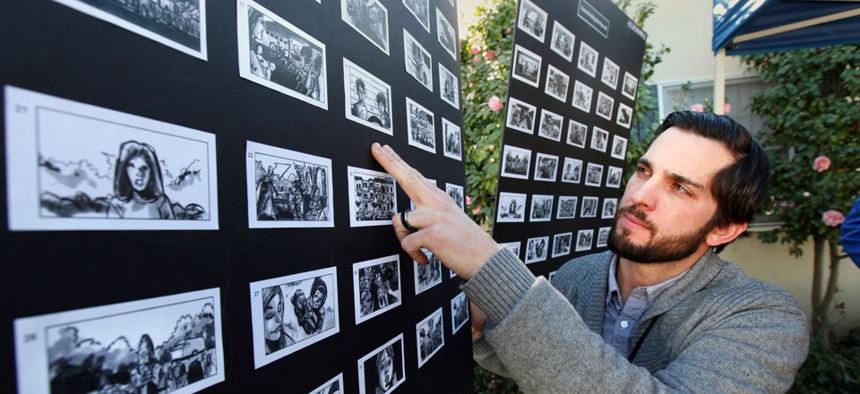Is Your Agency Ready to Start ‘Storyboarding?’

Nathan Crow, Creative Director at RPA: Rubin Postaer and Associates, an advertisement agency, checks a story board for a Superbowl ad. Nick Ut/AP
It's the latest buzzword humming through agencies.
Winston Chang is a director at The Ambit Group.
Dashboard. Cloud. Business intelligence.
As buzzwords and ever-changing acronyms flow in and out of our government vernacular, we race to lead our peers in adapting new technologies and methodologies -- sometimes at the cost of understanding the strengths and weaknesses of these innovative tools.
Storyboarding is the new "word of the day" and, like most great ideas, it can be used to great effect or misused at the owner's peril.
Storyboarding is a technique originally developed for film. It provided a quick and simplified visual telling of the movie using sketches. In film, the concept of ‘a picture is worth a thousand words’ worked to flush out potential issues early on, because filming was so expensive. This tool has been adapted for software development, requirements gathering, brainstorming, organizational methodology and many other applications.
Today, storyboarding retains the visual narrative format and can be used to help the government achieve its diverse set of ongoing missions.
What Storyboarding Gets Rights
Communication: Storyboarding gets everyone on the same page, presenting a shared vision. Even in the best circumstances, communication is often hindered by word usage, definitions and connotations that can vary from person to person. Similar to its use in the movie industry, the storyboard acts as an intermediate step, between the script and film, to get all parties in sync where vocabulary alone cannot.
The visual and narrative nature of a storyboard is easily understood and elicits clear feedback. The storyboard also acts as a focal point for productive dialogue and promotes a proper context around input collection.
Organization: The act of storyboarding forces a narrative format. As an organizational or brainstorming tool, storyboarding ensures your end product tells a story. Telling a story enhances socialization and buy-in for your project.
But there are even deeper benefits. Storyboarding brings the focus back to the customer’s needs. Project misalignment, creep and other risk factors can be mitigated if the customer’s problem can be clearly described and visualized.
Rapid Development: Storyboarding, when done correctly, is iterative and quick. Think a self-organizing, rapid and evolving development methodology. Sound familiar? As a development tool, the storyboard process requires iterative feedback to create a clearly represented narrative. It evolves into a representation of the customer’s voice.
As a brainstorming or organizational tool, the storyboarding process quickly and naturally drives the format into a narrative structure. Storyboarding can help leapfrog what traditionally could be long requirements gathering or structuring timeframes.
Where Storyboarding Falls Short
Doesn’t do small well: Storyboarding does not handle granular detail well. The narrative depicted by the storyboard benefits from a sprinkling of details here and there. But encompassing every minute point of a large project bogs it down.
This can be avoided by focusing storyboards on smaller segments of projects. However, this technique should be applied cautiously, as having too many storyboards can become an issue itself.
Not a final step: The storyboard -- and the process of storyboarding – is meant to be an interim step to take a project quickly through the early stages of development. The storyboard might seem like a great final deliverable because it is a shortcut to depicting the end state – but this is a trap to be avoided!
Ignoring the proper planning required for a successful project is a risk. Used as a tool in early or business-level requirement gathering, the storyboard quickly delivers an unpolished product that is 80 percent prototyped. It should act as a launch pad for the project plan or solutions development as opposed to an end product.
The government is slowly shifting to newer acquisition strategies, organizational structures and project management styles in order to function effectively in today’s rapidly changing environment. Storyboarding is a tool that stands out in this environment. Like any tool, the benefits increase exponentially with proper application and functional experience.
Speaking personally, I look forward to the day when storyboarding is no longer just a hot buzzword but a well understood and widely used technique.



 By
By